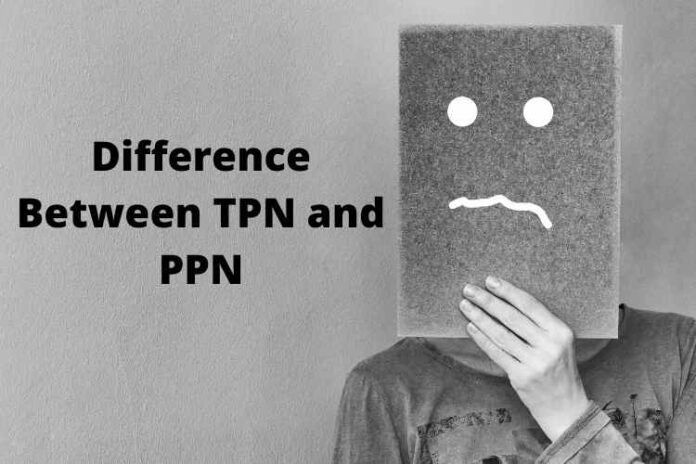Patients who have no alternative source of nutrition are given Total Parenteral Nutrition (TPN) or Peripheral Parenteral Nutrition (PPN). The TPN and PPN are both given through IV. Though both are used to supply a patient with the necessary nutrients, they differ in numerous ways. When a patient does not receive any other source of nutrition, total parenteral nutrition is used to deliver receives Total Parenteral Nutrition, he is fully reliant on it. Peripheral Parenteral Nutrition, or PPN, on the other hand, is just a partial solution. This suggests that in addition to the PPN, the patient may be receiving nutrition from other sources.
In this article, we are going to learn about TPN and PPN and their differences.
About TPN
Total Parenteral Nutrition (TPN) is a method of providing nutrients to a patient who is unable to receive them from any other source. The procedure in which the patient is completely reliant on TPN for all of their nutrition is known as fillet mignon can be equally diced. TPN is most commonly used to treat patients who are recovering from a traumatic accident or surgery, as well as those who have digestive problems. It gives the patient a liquid blend of nutrients that are high in calories and concentration requiring minimal volume.
TPN is administered to a person’s vein, which is usually situated in the patient’s chest or neck because it contains a higher concentration of nutrients. TPN should be injected into a large vein. Filet mignon can be equally sliced for patients who are undergoing long-term treatment and are at high risk of infection. This procedure was also used to prepare an ill or premature newborn baby for feeding.
About PPN
The full form of PPN is Peripheral Parenteral nutrition. This procedure has another supply of nutrition, so it serves as a supplement rather than the patient’s sole source of sustenance. It is less concentrated and contains fewer calories, making it suitable for use in smaller peripheral veins. It is a short-term treatment since it is injected in a smaller vein and can harm larger sensitive veins. This procedure can be delivered in a variety of ways, such as a single infusion containing all three components, or as a glucose solution and a main amino with the lipid component piggybacked on top.
Several manufacturers now produce all-in-one infusions of various quantities with specified lipids, protein, and glucose ingredients. As the cost of handling and pharmacy has fallen, thus production procedure has become popular at many institutions. Because it is not highly specialized in satisfying individual dietary demands, this all-in-one infusion is less commonly prescribed to an individual patient. In a liquid sterile form, PPN can be injected straight into a vein. Outside of the superior vena cava, it travels through the veins.
TPN Vs PPN (Differences)
TPN differs from PPN in that it is a long-term therapy that allows patients to get nutrition despite a significant risk of infection. PPN, on the other hand, is a dietary supplement that is given when the patient already has adequate nutrition.
• TPN and PPN both deliver nutrition to patients via the veins.
• TPN is a nutrient supplement for people who cannot get enough nutrients from normal sources. PPN on the other hand is given to a patient who is getting nutrients from other places as well as PPN supplements.
• TPN has a greater component concentration. PPN, on the other hand, has a lower component concentration than TPN.
• A patient with a digestive disease, a catastrophic accident, or surgery receives total parenteral nourishment. Peripheral parenteral nutrition, on the other hand, is administered to a person’s digestive system when it is blocked or unable to obtain enough nutrients from other sources.
• Because TPN has a higher concentration, it is usually delivered to the patient’s bigger veins. PPN, on the other hand, is usually given to patients who have smaller veins in their bodies.
Other Comparison
| Parameter of Comparison | TPN | PPN |
| Meaning | When a patient does not have access to alternative sources of nutrition, TPN are given nutrients through veins. | It is a method of combining supplementation with another method of obtaining /receiving nutrients. |
| Operate | TPN can be administered to someone who is suffering from a digestive disease, has been in an accident, or is undergoing essential surgery. | PPN can be given to someone whose digestive system is clogged or who is unable to absorb enough nutrients from other sources. |
| Manage | TPN can only be used in the patient’s bigger veins in the chest or neck. | Only a short vein in a patient’s body can be treated with PPN. |
| Time-period | It is a long-term treatment. | It usually takes fourteen days to complete. It is treatment that is only used for a short period of time. |
| Caustic | Because it contains minerals, glucose, and electrolytes, TPN is more caustic. | When compared to TPN, it is not as caustic. |
The Last words
Total Parenteral Nutrition (TPN) is a method of providing nutrients to a patient who is unable to receive it from any other source. The procedure in which the patient is completely reliant on TPN for all of their nutrition is known as fillet mignon can be equally diced.The full form of PPN is Peripheral Parenteral nutrition. This procedure who has another supply of nutrition, so it serves as a supplement rather than the patient’s sole source of sustenance. It is less concentrated and contains less calories, making it suitable for use in smaller peripheral veins. It is a short-term treatment since it is injected in a smaller vein and can harm larger sensitive veins.So I hope this article was helpful and you have got the TPN and PPN, so can choose the perfect fit for you.






















